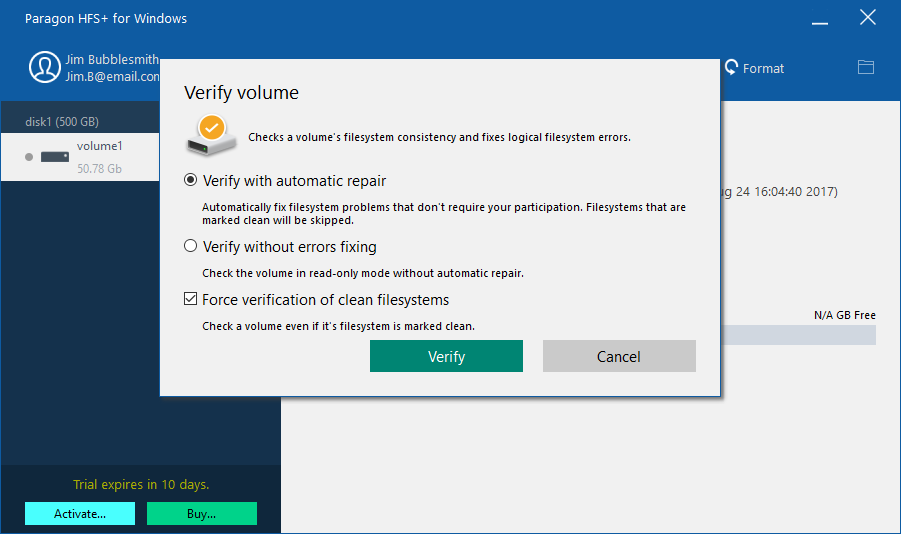

- #Open external hard drive formatted for mac on pc how to
- #Open external hard drive formatted for mac on pc full
- #Open external hard drive formatted for mac on pc windows 10
- #Open external hard drive formatted for mac on pc software
- #Open external hard drive formatted for mac on pc Pc

Once that is selected you can give your external hard drive a name if you would like to and then you can click Start to format the drive, this will permanently delete all the information and files on the external drive so ensure you have copied all your data off the drive before formatting – you are responsible for the data on your device so make sure it is in a safe place.

In this utility, click the dropdown menu for File system and select ExFAT, this is a drive format that is compatible with both macOS and Windows for reading and writing data, for more information on ExFAT take a look at these resources. via ‘Mail’.To format your drive, firstly right click on the external drive listing in Explorer and then select the Format from the dropdown list of options, this will then open the disk formatting utility in Windows. From here you can choose various methods to send your sharing link e.g. To do this, right-click on any file, then hover your mouse over ‘Share’. Once you’ve opened the files and made any changes you need, you can send a sharing link to others if you wish. The Mac operating system will automatically sync the files to Apple’s servers. If you don’t see this is the side pane, open System Preferences > iCloud to check you’re signed in and that this service is enabled. To take advantage of iCloud, simply open your Windows drive in Finder then copy and paste any files you want to work with to the location ‘iCloud Drive’. Online services such as iCloud Drive offer a generous free allowance (5GB) and allow you to immediately sync, edit and share files even if they were originally created for Windows and saved to an NTFS disk. If you only want to work or collaborate on a few files, why not ditch the drives altogether and place your files in the Cloud?
#Open external hard drive formatted for mac on pc windows 10
When using BootCamp remember that any files you save to the Windows 10 section of the hard disk itself can’t be accessed when you reboot into macOS and vice versa.
#Open external hard drive formatted for mac on pc Pc
If you enjoy using the iWorks app however (Pages, Keynotes & Numbers), you can work with the online versions of these tools on a PC by accessing iCloud via your browser. You’ll also naturally will have to work with files using Microsoft apps instead of those designed for Mac like iMovie.
#Open external hard drive formatted for mac on pc how to
See our guide on setting up BootCamp for more details on how to get started.Īlthough BootCamp is easy to set up and use, you must purchase a Windows 10 license to keep using the OS after 90 days. To get started, all you need is an internet connection, a valid Windows 10 DVD and a USB stick of at least 8GB. This includes working with NTFS-formatted drives. Once set up, Windows 10 will function on your Mac in just the same way as it would on a regular PC. This allows you to boot both operating systems on your Mac. During the setup process, users shrink the size of their existing macOS installation to make room for Windows. The most recent version of macOS ( Mojave) supports Windows 10. You should now be able to edit existing files and copy new ones here.īootcamp is macOS’ own built-in utility for installing Microsoft Windows on your Mac. Open Finder, then click Go’> Go to Folder, then type ‘/Volumes/NAME’ where ‘NAME’ is the name of your NTFS drive.Ĭlick ‘Go’ to access your Windows disk. Next, connect your Windows drive to the Mac. Press Ctrl+O to save the list, and then press Ctrl+X to exit NANO. USB1 (if you’re unsure what this is, simply open Disk Utility): LABEL=NAME none ntfs rw,auto,nobrowse Use the arrow keys on your keyboard to scroll to the very end and add the following line, replacing ‘NAME’ with the actual name of your NTFS drive e.g. This will open the list of drives recognised by macOS. Connect your NTFS drive, then enter the command: sudo nano /etc/fstab To get started, click the Spotlight icon at the top right of your screen and enter ‘Terminal’. As this feature is still in the testing phase however, your files could become corrupted at anytime, so proceed with caution.

#Open external hard drive formatted for mac on pc software
The main benefit of using Terminal in this way is that it’s quick to do and no third-party software is required.
#Open external hard drive formatted for mac on pc full
This is an experimental feature and could lead to data loss, so make sure to do a full backup of both your Mac and any data on the drive before continuing. If reformatting your NTFS drive for Mac is not an option, you can enable write support for specific Windows disks using macOS Terminal.


 0 kommentar(er)
0 kommentar(er)
